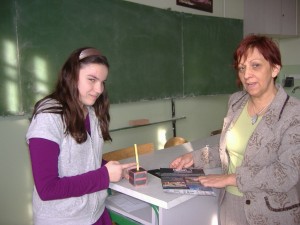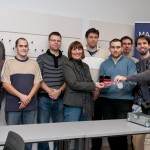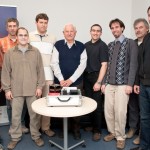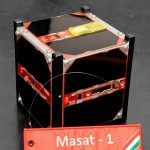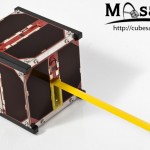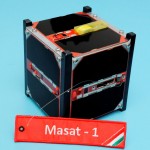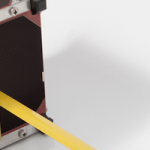A Masat-1 felbocsátási kampányának közepén (szinte a végén) nem is olvashattunk volna örömtelibb hírt, mint hogy 2012 közepén döntés születik arról, hogy Magyarország teljes jogú tagja lesz az Európai Űrügynökségnek (ESA). Nagyon várjuk a pozitív döntést, így Csehország és Románia után hazánk is óriási lehetőséghez juthat. A jelenleg érvényben lévő PECS (előtagsági) szerződésnek ránk nézve is nagy hatása volt. Az egyetemen azok a hallgatók készítették az első magyar műholdat, akik PECS projektekben (pl.: ESEO, ESMO) már tapasztalatokat szereztek és a Vega rakétára való felkerüléshez is hátszelet biztosított. Az irány jó, hajrá!
Támogatókat gyűjtve többen, többször tartunk Masat ismertetéseket, előadásokat. El kell ismerni, korban verhetetlen Kocsis-Nagy Kinga a szegedi Juhász Gyula Gyakorló Általános Iskola 6.c osztályának tanulója. Kinga a Horváthné Fazekas Erika fizika tanárnő vezette órán, kiselőadás keretében ismertette a Masat -1 felépítést, küldetésének célját. Az előadást egy, saját maga által összerakott Masat papír kockával illusztrálta. Sajnálja, hogy a Masat-1, repülése után, nem jöhet vissza hazájába akkor se ha mindent jól teljesített.Szereti mert kicsi mint ő és magyar. A felkészítésért köszönet Dr. Kovács Eszternek.
Képünkön Kinga és tanárnője látható.
Miután az ESA szakemberei átvették a műholdat, megkezdődött az integráció. A Masat-1-et a többi kisműholddal együtt átszállították a franciaországi Toulouse-ba, ahol behelyeztük a 3 P-POD közül a másodikba. A második P-POD, középső pozíciója lett a miénk, a műholdak sorrendje bentről kifelé:
- PW-Sat
- Masat-1
- Robusta
A Masat jó állapotban van, az integrációt követően ellenőriztük, hogy minden napeleme, antennája sértetlen-e és az akkumulátor töltöttségét is megmértük. A mérések után az összeszerelt P-POD-ot rázáspróbának vetették alá, amin sikeresen vizsgázott az integrált rendszer. Így zöld utat kaptunk és következő lépésként már a P-POD-ok felhelyezése várható a LARES rendszerre. December elején irány Francia Guyana, ahol még egy utolsó akkumulátor töltés és szemrevételezés vár ránk és a Masat-ra.
Az hosszas műszaki és adminisztratív tárgyalásokat követően az Európai Űrügynökség jóváhagyta, hogy a Masat-1 integrálásra kerüljön a Vegán lévő 2 darab 3 egységes P-POD egyikébe. Ezek után kiutaztunk az ESA technológiai központjába. Itt történt meg az átadás-átvétel, az ellenőrzések és a további teendők egyeztetése. A repülő példányról és a búcsúztatásról készült néhány fényképet szeretnénk megosztani. Még elég sok teendő van a start előtt, amint lehetőségünk lesz rá, bővítjük a képeket!
Az első két csapatfotón a fejlesztők és a két tanszék vezetői láthatók. Az első képen, balról jobbra: Horváth Gyula, Dudás Levente, Glisics Sándor, Dr. Rencz Márta, Temesvölgyi Tamás, Kovács Zoltán, Marosy Gábor és Czifra Dávid. Középen a Masat-1 repülő példánya. Kofferben a Masat-1 tömegmodellje. A második csapatfotón balról jobbra: Marosy Gábor, Szimler András, Dudás Levente, Temesvölgyi Tamás, Dr. Gschwindt András, Kovács Zoltán, Czifra Dávid, Dr. Nagy Lajos és Horváth Gyula. Középen a Masat-1 szállító doboza a tömegmodellel.
A további képeken a Masat-1 repülő példánya látható. Köszönjük szponzorainknak és partnereinknek, hogy bíztak bennünk és természetesen mindenkinek, aki velünk együtt drukkol a sikerért!
Igyekszünk az eseményekről részletesen tudósítani, további részletek, képek később…
ESA Cubs delivered for first Vega flight
Némi információ a Vega rakétáról:
First Vega launch campaign aims for January liftoff
Az eredetileg tervezett PSLV startok csúszásai miatt kértük a felbocsátást szervező céget, hogy a lehetséges hordozók körét bővítse ki a PSLV-ről Soyuzra is. Ezen módosítás bár magasabb startköltséget jelent számunkra, azonban így elképzelhető, hogy 2012. 3. negyedévére a Masat-1 már pályára is állhat. Ahhoz azonban, hogy ez a start lehetőség megvalósulhasson, további szponzorok jelentkezését szeretnénk kérni.
Az Európai Űrügynökség (ESA) Oktatási Osztálya legalább 6 darab 1U CubeSat felbocsájtását tervezi 2012. január végén az új VEGA hordozóval. Bár a hordozóra történő felkerülés pályáztatása már korábban lezajlott, ennek ellenére a BME a Masat-1 -el tartalékműholdnak jelentkezett. A tartalékműholdak akkor repülhetnek, ha valamely korábban sikeresen pályázott műhold, nem készül el a kiírt határidőre. A VEGA hordozó első startja nagy kockázatot képvisel a bejáratott PSLV és Soyuz rakétákhoz képest, így szeretnénk továbbra is fenntartani az alternatív startlehetőséget is.
Együttműködés
Szponzorok
- AduPrint
- Altium
- Anico Kft.
- Azurspace
- BL-Electronics
- Bonn Hungary
- Carinex
- ChipCAD
- COOPTIM Ipari Kft
- Dension
- DND Telecom Center Kft.
- DSI Informationstechnik
- Dunaújvárosi Főiskola
- EADS Astrium GmbH
- ELMŰ
- Europrint
- Evosoft
- Exasol Kft.
- Faludi Wolf Theiss
- Farmelco Kft.
- GD Gép és Daru Kft.
- HFT Kft.
- HP Magyarország
- Hungaro DigiTel Kft.
- Infoterra Hungary Kft
- KFKI RMKI
- LHT Budapest
- LOMEX
- Magnetec-Ungarn
- Magyar Villamos Művek
- Magyarok a Marson
- Microchip
- National Instruments
- Nikon
- NMHH
- NuSil
- Paksi Atomerőmű
- Puskás Technikum
- Rádióvilág
- Ricoh Hungary Kft.
- RSOE
- Sagax Kft.
- SGF Kft.
- Siemens
- Silicon Labs
- Sphere Consulting Kft.
- Totaltel
- Űrvilág Hírportál
- Wacker Chemie
Tervezőrendszerek
Naptár
| h | K | s | c | p | s | v |
|---|---|---|---|---|---|---|
| 1 | 2 | 3 | 4 | 5 | 6 | |
| 7 | 8 | 9 | 10 | 11 | 12 | 13 |
| 14 | 15 | 16 | 17 | 18 | 19 | 20 |
| 21 | 22 | 23 | 24 | 25 | 26 | 27 |
| 28 | 29 | 30 | ||||





